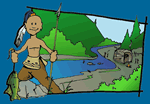


Geography and Landforms:
Although Wisconsin is not a coastal state, it is largely defined by water. Its eastern border is the shoreline of Lake Michigan. The northwestern border is Lake Superior. The Mississippi River forms the border between Wisconsin and Minnesota, as well as the border between Wisconsin and Iowa. A tributary of the Mississippi, the St. Croix River, forms the rest of the western border. Only the border between Wisconsin and Illinois to the south is dry.
|
 History:
The first European explorer to reach what is now Wisconsin was Jean Nicolet, a Frenchman who landed along the shore of Green Bay while he was looking for a Northwest Passage to China in 1634. About 250 years ago, French fur traders and Roman Catholic missionaries arrived to begin settling the area. The French gave possession of the area to England following the French and Indian War in the 1760s. The first permanent European settlement was established in 1764 by Charles Langlade. The British, in turn, lost its control of the area in 1783 following the American Revolution. However, because of its location, the new government of the United States was unable to exercise much influence over the area, and it remained under the influence of its British settlers for some time.
|
 Economy:
Natural resources have always been important to the economy of Wisconsin. Very early settlers were fur traders, and the population of the territory expanded quickly when lead was discovered and began to be mined. By the early 1900s, the lumber industry began to be important in Wisconsin, and then businesses creating furniture, paper products and wagons. During the mid-1900s, the economy gradually began to shift away from agriculture toward manufacturing.
|
 First Inhabitants:
As long ago as 10,000 years ago, Paleo-Indians came through Wisconsin hunting wooly mammoth, mastodon, and bison. After the retreat of the glaciers, the climate improved and people began to live in caves, along rivers, and around lakes. They hunted smaller animals like deer and elk, and harvested wild plants, nuts, and acorns. During the Woodland Period, around 3,000 years ago, people began to live together in villages, and use bows and arrows to hunt. They built burial mounds for their dead.
|
Books Related To WisconsinB is for Badger: A Wisconsin Alphabet - Kathy-Jo Wargin Bird Lake Moon - Kevin Henkes Caddie Woodlawn - Carol Ryrie Brink Dairy Queen - Catherine Murdock The Game of Silence - Louise Erdrich The Giant Ball of String - Arthur Geisert Ida B: -- And Her Plans to Maximize Fun, Avoid Disaster, and (Possibly) Save the World - Katherine Hannigan The Island - Gary Paulsen Oggie Cooder - Sarah Weeks Thimble Summer - Elizabeth Enright Winter Days in the Big Woods - Laura Ingalls Wilder |
Famous Citizens:
|
| Capital: | Madison |
| Entered Union: | May 29, 1848 |
| Population: | 5,757,564 |
| Area | 65,498 |
| Bird | Robin |
| Flower | Wood Violet |
| Nickname: | Badger State |
| Governor | Scott Walker |
Places to Visit in Wisconsin: (Click the links to learn more.)
|



